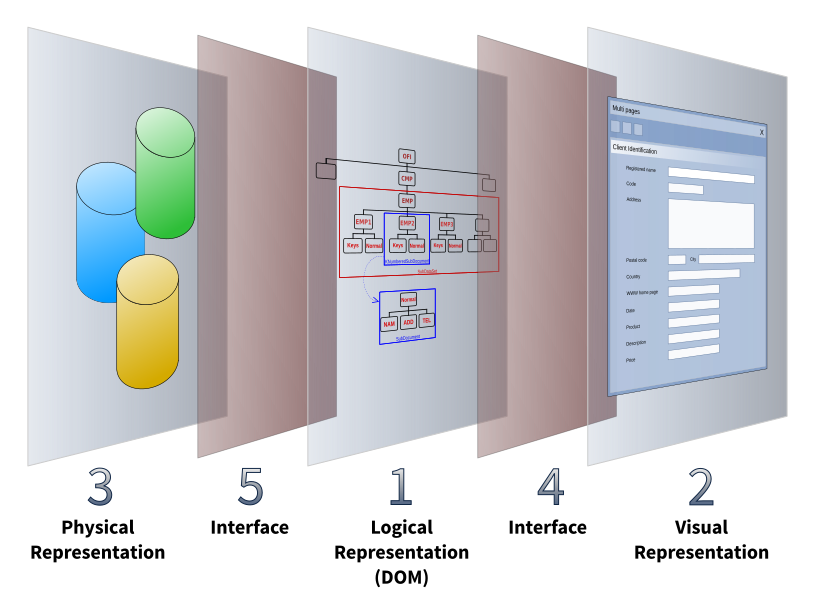SOClass Concepts
SOClass is designed to offer solutions based on an n-tier model.
An n-tier application program is distributed among three or more separate computers or logical layers in a distributed network environment. The most common form of n-tier (meaning “some number of tiers” is the 3-tier application, in which user interface application resides on the end-users’ computers, business logic resides on a centralized computer, and data requirements are handled by another computer managing a database. In addition to their induced orderliness of programming, n-tier applications have the obvious advantage that any of the tiers can run on a most appropriate processor or operating system, offering great scalability and capacity of evolution.

As SOClass is an entirely Java system, it faithfully observes the popular “run anywhere” concept, as popularised by Java vendors. The distinct advantage for customers, and in particular governments, being that SOClass implementations can comply with IT development policies, previously established. For example, SOClass can work with any type of database management system supporting a JDBC driver or an ODBC driver trough a JDBC-ODBC bridge.
As a data-centric object, the e-document revolves around the data and logic it embeds. The SOClass data model is an hierarchical representation of the data contained in the e-document. Data can be viewed as a tree made of branches and data leaves – or data elements. This hierarchical representation proves natural and facilitates the analysis of the functional requirements. In addition, it eases the coding of the business logic through rules attached as adequate to tree nodes or leaves.
Another advantage of the tree structure of data is that it complies with XML basic structure requirements. SOClass includes XML parser technology to export and import XML documents to and from external systems.
The Graphic User Interface (GUI) tier can be specific to each application, and each document, or harmonized around SOClass standard design. SOClass visual tools and examples allows beginners to quickly develop great document visual interfaces – or document skins – but also render possible for advanced programmers to plug-in more complex proprietary ones. The standard SOClass visual representation of a document comprises one or more forms, each comprising one or more pages.
SOClass integrates a number of specific technologies; an impressive one is certainly the Fault Tolerant Network Protocol (FTNetP). This technology significantly enhances the Java Remote Method Invocation (RMI) system, bringing major benefits.
An n-tier application program is distributed among three or more separate computers or logical layers in a distributed network environment. The most common form of n-tier (meaning “some number of tiers” is the 3-tier application, in which user interface application resides on the end-users’ computers, business logic resides on a centralized computer, and data requirements are handled by another computer managing a database. In addition to their induced orderliness of programming, n-tier applications have the obvious advantage that any of the tiers can run on a most appropriate processor or operating system, offering great scalability and capacity of evolution.
As SOClass is an entirely Java system, it faithfully observes the popular “run anywhere” concept, as popularised by Java vendors. The distinct advantage for customers, and in particular governments, being that SOClass implementations can comply with IT development policies, previously established. For example, SOClass can work with any type of database management system supporting a JDBC driver or an ODBC driver trough a JDBC-ODBC bridge.
As a data-centric object, the e-document revolves around the data and logic it embeds. The SOClass data model is an hierarchical representation of the data contained in the e-document. Data can be viewed as a tree made of branches and data leaves – or data elements. This hierarchical representation proves natural and facilitates the analysis of the functional requirements. In addition, it eases the coding of the business logic through rules attached as adequate to tree nodes or leaves.
Another advantage of the tree structure of data is that it complies with XML basic structure requirements. SOClass includes XML parser technology to export and import XML documents to and from external systems.
The Graphic User Interface (GUI) tier can be specific to each application, and each document, or harmonized around SOClass standard design. SOClass visual tools and examples allows beginners to quickly develop great document visual interfaces – or document skins – but also render possible for advanced programmers to plug-in more complex proprietary ones. The standard SOClass visual representation of a document comprises one or more forms, each comprising one or more pages.
SOClass integrates a number of specific technologies; an impressive one is certainly the Fault Tolerant Network Protocol (FTNetP). This technology significantly enhances the Java Remote Method Invocation (RMI) system, bringing major benefits.
Related Articles
SOClass Developer
SOClass Developer provides rich development environment for creating e-documents and application modules. It includes the SOClass Development Server and Client, as well as the Advanced Development Kit (ADK). The ADK includes demonstration ...SOClass JMX
JMX Technology is a standard Java technology that allows monitoring and management of Java resources and applications. This technology supports also RMI which means that it allows remote control and monitoring. The monitored resources are ...SOClass e-Document Server
SOClass e-Document Server provides the production environment for the customers. It includes SOClass Application Sever, SOClass Client and SOClass ULA. Modules created and tested with the SOClass Developer are easily installed on SOClass e-Document ...Java Technologies in SOClass
The SOClass Platform is developed with Java programming language and uses a great variety of Java technologies in order to provide the flexibility and security that the customers need. The main Java technologies used for building the SOClass Platform ...SOClass Mail
MailBox The purpose of the MailBox application is to provide a good communication between all users of the system and to provide a higher security level. MailBox The MailBox is an internal, system-dedicated application, which means that users can ...